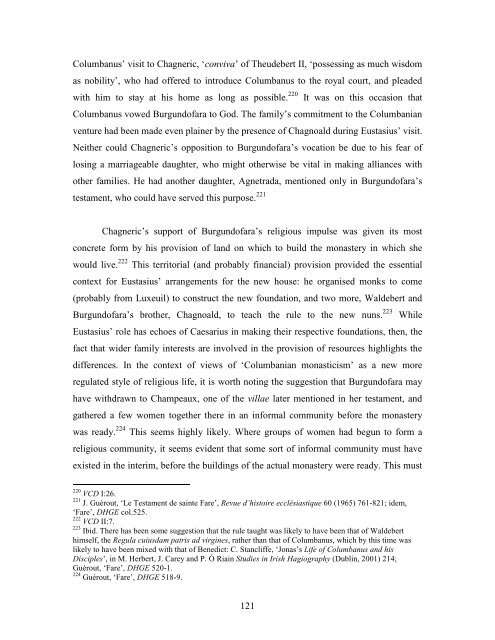Lindsay Rudge PhD Thesis - University of St Andrews
Lindsay Rudge PhD Thesis - University of St Andrews
Lindsay Rudge PhD Thesis - University of St Andrews
You also want an ePaper? Increase the reach of your titles
YUMPU automatically turns print PDFs into web optimized ePapers that Google loves.
Columbanus’ visit to Chagneric, ‘conviva’ <strong>of</strong> Theudebert II, ‘possessing as much wisdom<br />
as nobility’, who had <strong>of</strong>fered to introduce Columbanus to the royal court, and pleaded<br />
with him to stay at his home as long as possible. 220 It was on this occasion that<br />
Columbanus vowed Burgund<strong>of</strong>ara to God. The family’s commitment to the Columbanian<br />
venture had been made even plainer by the presence <strong>of</strong> Chagnoald during Eustasius’ visit.<br />
Neither could Chagneric’s opposition to Burgund<strong>of</strong>ara’s vocation be due to his fear <strong>of</strong><br />
losing a marriageable daughter, who might otherwise be vital in making alliances with<br />
other families. He had another daughter, Agnetrada, mentioned only in Burgund<strong>of</strong>ara’s<br />
testament, who could have served this purpose. 221<br />
Chagneric’s support <strong>of</strong> Burgund<strong>of</strong>ara’s religious impulse was given its most<br />
concrete form by his provision <strong>of</strong> land on which to build the monastery in which she<br />
would live. 222 This territorial (and probably financial) provision provided the essential<br />
context for Eustasius’ arrangements for the new house: he organised monks to come<br />
(probably from Luxeuil) to construct the new foundation, and two more, Waldebert and<br />
Burgund<strong>of</strong>ara’s brother, Chagnoald, to teach the rule to the new nuns. 223 While<br />
Eustasius’ role has echoes <strong>of</strong> Caesarius in making their respective foundations, then, the<br />
fact that wider family interests are involved in the provision <strong>of</strong> resources highlights the<br />
differences. In the context <strong>of</strong> views <strong>of</strong> ‘Columbanian monasticism’ as a new more<br />
regulated style <strong>of</strong> religious life, it is worth noting the suggestion that Burgund<strong>of</strong>ara may<br />
have withdrawn to Champeaux, one <strong>of</strong> the villae later mentioned in her testament, and<br />
gathered a few women together there in an informal community before the monastery<br />
was ready. 224 This seems highly likely. Where groups <strong>of</strong> women had begun to form a<br />
religious community, it seems evident that some sort <strong>of</strong> informal community must have<br />
existed in the interim, before the buildings <strong>of</strong> the actual monastery were ready. This must<br />
220<br />
VCD I:26.<br />
221<br />
J. Guérout, ‘Le Testament de sainte Fare’, Revue d’histoire ecclésiastique 60 (1965) 761-821; idem,<br />
‘Fare’, DHGE col.525.<br />
222<br />
VCD II:7.<br />
223<br />
Ibid. There has been some suggestion that the rule taught was likely to have been that <strong>of</strong> Waldebert<br />
himself, the Regula cuiusdam patris ad virgines, rather than that <strong>of</strong> Columbanus, which by this time was<br />
likely to have been mixed with that <strong>of</strong> Benedict: C. <strong>St</strong>ancliffe, ‘Jonas’s Life <strong>of</strong> Columbanus and his<br />
Disciples’, in M. Herbert, J. Carey and P. Ó Riain <strong>St</strong>udies in Irish Hagiography (Dublin, 2001) 214;<br />
Guérout, ‘Fare’, DHGE 520-1.<br />
224<br />
Guérout, ‘Fare’, DHGE 518-9.<br />
121

















